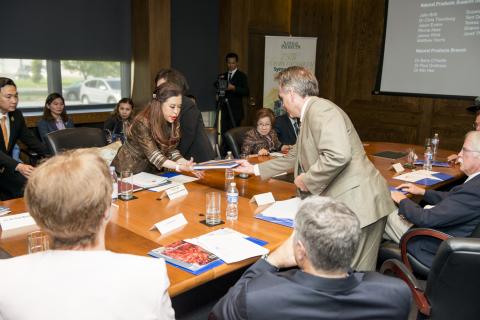
Professor Dr. Her Royal Highness Princess Chulabhorn Mahidol accepts a commemorative book of data from Barry O’Keefe, deputy chief, Molecular Targets Laboratory, and chief, Natural Products Branch, during her visit to NCI at Frederick.
The Center for Cancer Research (CCR) and NCI at Frederick recently had the honor of hosting Professor Dr. Her Royal Highness Princess Chulabhorn Mahidol of Thailand. Her Royal Highness has a special interest in scientific research related to the use of natural products for treating disease.
The purpose of her visit was to discuss the work on natural products being undertaken at NCI at Frederick. Her Royal Highness attended talks by researchers from both the Molecular Targets Laboratory (MTL), CCR, and the Natural Products Branch (NPB), Developmental Therapeutics Program (DTP), Division of Cancer Treatment and Diagnosis (DCTD). Her Royal Highness also received an update on NCI’s role in the collaboration between the Chulabhorn Research Institute in Thailand and NCI’s NPB.
The mini-symposium was opened by Barry O’Keefe, Ph.D., deputy chief, MTL, and chief, NPB, who welcomed Her Royal Highness and the Thai delegation to the NCI at Frederick campus, and explained that currently less than 1 percent of the biome has been examined for potential therapeutics for cancer and other illnesses. He added that the NPB and the MTL have worked together on examining the natural products that are collected around the world and sent to NCI at Frederick for potential therapeutic uses.
Jim McMahon, Ph.D., chief, MTL, then spoke about the project screenings and assay development performed in his lab. The MTL develops primary and secondary screening assays that help isolate and identify a variety of products obtained from organisms found in the natural environment worldwide.
McMahon explained that NCI has one of the world’s largest and most diverse repositories of natural products, making it a unique resource. The MTL developed a prefractionation process that has helped enhance its screening assays. Based on MTL’s work, McMahon showed four molecules that have been found and are now in various stages of clinical trials.
Next, Kirk Gustafson, Ph.D., senior scientist, MTL, described anti-HIV activity that was found in natural products as the result of an anti-HIV screening assay developed in 1988. These first products were sulfolipids obtained from three different cultured cyanobacteria.
Gustafson went on to explain how natural products have proven to be a rich resource of diversity of antiviral activity. A new family of cyclic plant peptides, now referred to as cyclotides, has been shown to exhibit activity against HIV. Another natural protein, cyanovirin, works against HIV by binding to specific oligosaccharides on the viral envelope and inhibiting HIV entry into cells. In vivo testing showed that cyanovirin effectively prevented simian HIV transmission in macaques, and it has also been shown to inhibit influenza, hepatitis C, and the Ebola virus. Currently, cyanovirin is in preclinical development for use as a topical microbicide to prevent sexual transmission of HIV.
For more than 50 years, the NPB has operated a collection program that includes plants, marine invertebrates, and microbes. Prior to 1981, outside organizations would submit materials to NCI for processing and assaying. Then these organizations would collaborate with industry and academia to identify active agents and develop promising compounds, NPB Chemist Paul Grothaus, Ph.D., said during his presentation. However, because there were no official collaboration agreements that outlined the ownership of the discoveries, the original program was stopped in 1981 and reassessed. This reassessment led to the current program and process that began in 1986. This process established the use of the 60–human tumor cell line assay, the organization of specialist collection and curation methods, the Natural Products Repository (NPR), the development of a standardized system amenable to parallel processing of large numbers of samples, and the agreements that cover benefits to source countries; it also permitted worldwide access to the NPR for research on human diseases.
In her presentation, Tanja Grkovic, Ph.D., senior scientist, Natural Products Support Group (NPSG), Leidos Biomedical Research, outlined the many contributions that the NPSG has made to the NCI–Chulabhorn Research Institute collaboration. She explained how the NPSG processes crude extracts through prefractionation to obtain a pure compound that can be further tested for potential therapeutic uses. Grkovic presented data on the initial studies of one of the organisms collected as part of the collaboration. From that organism, NPSG researchers identified both a known and a new compound, which they are currently analyzing for potential anticancer activity.
At the conclusion of the symposium, O’Keefe presented Her Royal Highness with a book that contained data on the Thailand collections to date.
When asked about the symposium and visit, O’Keefe said, “We were honored to have Professor Dr. Her Royal Highness Princess Chulabhorn Mahidol of Thailand visit the NCI at Frederick. As a professor herself, she has been a long-time supporter of science and, in particular, research into natural products. The NCI’s current collaboration with the Chulabhorn Research Institute is already productive, and we hope to continue to build upon our common research goals.”
For more information about the work of the MTL, see “All Natural Chemicals,” in CCR Connections.

